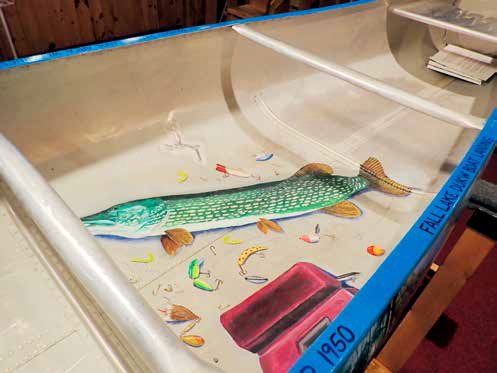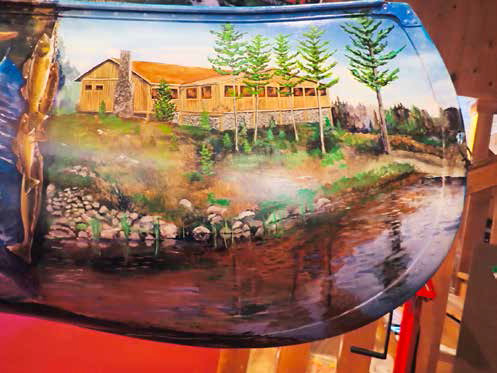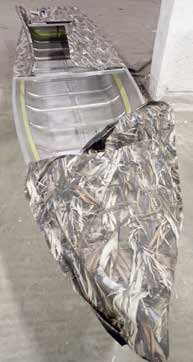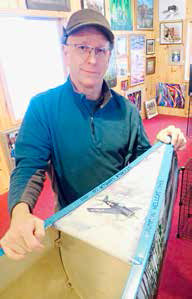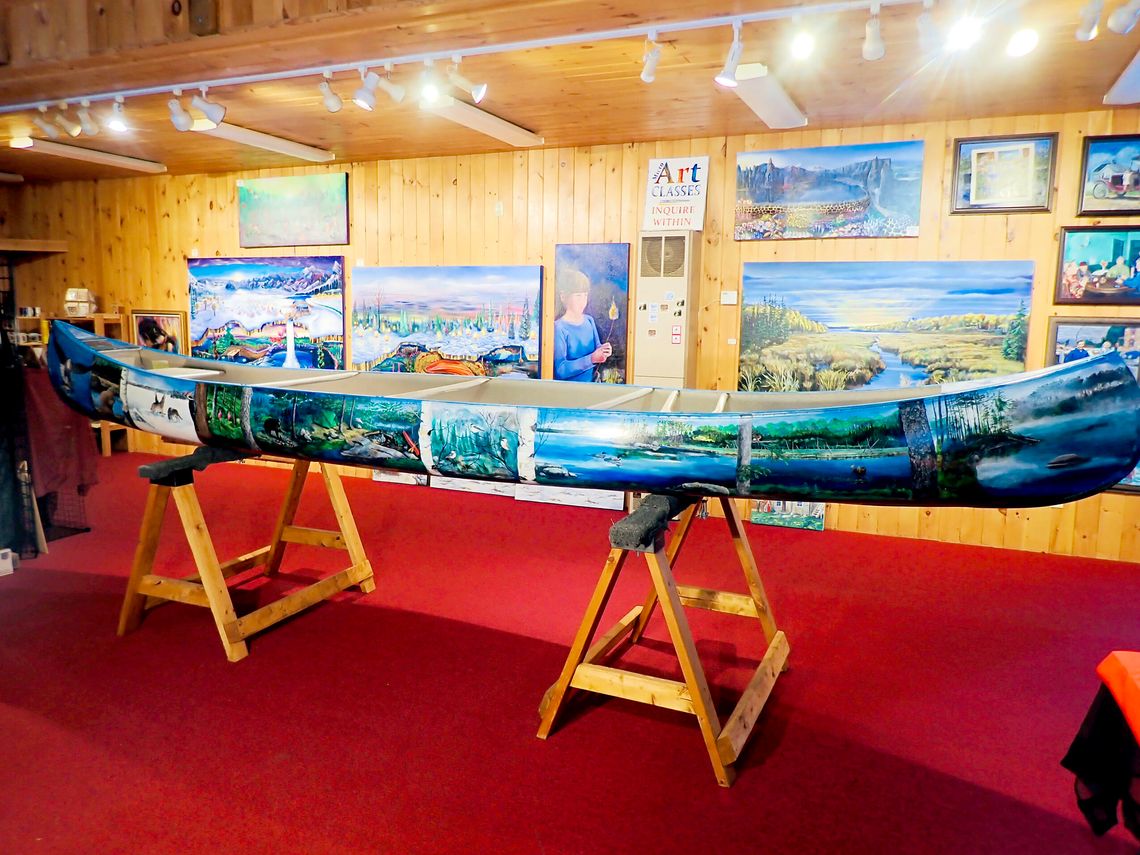(Part Three of the story of the Grumman Canoe that played a key role in Ely’s tourism history and how the Boundary Waters came to be known as canoe country. The story continues from Marathon Boat Works where the canoes are built.)
Extrusion
There is an extruded section of metal used on the keel and the gunwales. The extrusion is thicker and is formed in a metal processing plant by squeezing a soft aluminum billet between two dies, forcing the metal into the shape of the die. On a 19-foot square stern, there is a bulb-shaped T extrusion used for the keel. All the canoes have extruded gunwale pieces attaching to the skins. This is a reinforcing piece and adds strength. The extrusions are shaped in a forming machine to form a gentle radius or curve, and then will be drilled and riveted to the skin.
Ribs
Separate rib pieces formed by the large press are then placed inside the canoe and riveted. Each length of canoe and each weight of canoe requires a specific number of ribs. For example, a .050 thickness standard weight, vs .040 thickness for the lightweight canoe, the same length canoe will have a different number of ribs.
Flotation
After walking the entire length of the concrete floor, we approached a small workstation. I kind of laughed when I realized the purpose and simplicity of a cutoff bow section being used as a mold for a fast-setting spray foam. The hinged bulkhead was the giveaway; what a perfect mold for the Coast Guard flotation requirement. I had forgotten about the flotation requirement and the perfectly shaped foam piece fitting snugly inside the bow and stern bulkheads.
Painting
We met a young man wearing a stained red sweatshirt as we walked past the paint booth. I asked him his name.
“Dustin Oare,” We shook hands, “How long have you worked here?”
“I’ve been here about a year and a half now,” Dustin is 31 years old and comes from the Adirondack region north of here. At 20 years old, he started at Marathon, but then he left to work other jobs. He does the painting but also fabricates and helps wherever he is needed.
Nathasha led me down a short, wide, concrete ramp into the lower part of the factory. The lower level is where the Dura Nautic boat line is produced. We could hear the whirring sound while watching a man gripping an air drill. He had long grey hair and a beard, his eyes were hidden behind a pair of wirerimmed glasses. Nathasha introduced us, and of course, we shook hands, and he told me his name was Donny Wheeler. I thought maybe he had been working at Marathon for a while, and wondered if he lived in Marathon.
“Don, did you grow up here in Marathon?”
“No, Whitney Point, it’s real close though.”
Don went on to explain his working career; he is in his early sixties. Most of it at Grumman, beginning after high school on the midnight shift, at that time, three shifts were producing the aluminum canoe. After a year or two, he was laid off and found other work for a few years. Grumman called him back; he worked again for a few years building canoes and then started his own business. In 2007, he was back at Grumman. I asked him about the metal work and why he likes working at Marathon. He told me he just loves boats. He also told me “My mother worked here, my two brothers worked here, and my dad worked here.” But those were the days when the Grumman canoes were being pumped out by the thousands.
We were on the lower level of the factory. Nathasha and I walked across the floor where a Sportboat was being prepped for a boat show in Florida. She suggested I see this before leaving. They designed a duck blind to fit the sportboat. It was amazing! A set of ingenious popopen doors surrounds the shooter. The camouflage paint scheme was painted and designed by Dustin. I’m not sure if they ever marketed the blind, but it seems to me it would be a great success.
It was approaching 1120hrs and time to head back to Syracuse for my flight. We walked outside to an overcast sky with patches of pale blue beginning to poke through. Nathasha and I said goodbye. I thanked her again and as I drove away, glinting in the rear view mirror was the precision fabrication of sheet aluminum, the unfinished 19foot square stern. It gave me a good feeling and a better understanding of how an iconic wilderness canoe unknowingly inserted itself into the history of the Vermilion Iron Range.
After returning to the Vermilion Range, I met up with Nick Wognum to share a little about the story.
“Karl, you need to talk to Joe Baltich about his painted canoe.”
So, I pointed my Lincoln in a northeast direction toward Jasper Lake, a 35-minute drive up the Fernberg Trail. I passed through Winton, and by the old resorts of Sunny Dene, Squaw Bay, and Cliff Wold’s bunkhouse, continuing over the Garden Lake Bridge, then passed by Fall Lake Landing. I kept driving past Glacier Pond and Tofte Lake towards Moose Lake and Lake One.
It was a clear, cold Sunday afternoon, Super Bowl Sunday to some, but just a normal winter Sunday to the artist in residence I was about to meet. The Grumman story cannot be complete until an Ely artisan with family historical ties tells his story about the Grumman canoe and its effect on the wilderness area.
After arriving at Jasper Lake, I opened the door.
“Hey, Joe!” First, I heard only a dead silence and then I heard a muffled voice as Joe came down the stairs from the upper level of his studio.
“Hey Karl” We shook hands, of course. I don’t think I’ve seen Joe since 1978, but that’s ok, he was a good friend of one of my brothers, we all graduated from Ely, and we all knew each other, it’s just something about the kindergarten to high school camaraderie of being a Vermilion Ranger.
In the gallery, I was staring at a Grumman 17-foot double-end canoe; it was not shiny aluminum metal.
This canoe should be in a museum.
And I guess it is. It rests on carpeted sawhorses with spotlights focusing downward in a gallery of artistic expression. My head swiveling like an owl in every direction began gathering the bits and moments while adjusting time to relive local history.
The intensity of outdoor scenes is something a sophisticated digital camera can’t come close to replicating. And this is because of the detailed brush strokes and blended pigments of a talented artist who, a long time ago, had another not-so-visible talent, the playing of a reed band instrument under the direction of Mr. Klein and his famous tuba.
While I was talking with Joe, he said this about his painted Grumman canoe.
“I painted this canoe in 2016, it was a rental canoe traveling to all four corners of the BWCA.”
The canoe was put into outfitting service in 1988. After many years and water miles, it was removed from the rental fleet. As I approached the canoe after entering the gallery, my eyes glanced beneath the middle thwart and along the inner skin. Immediately, I noticed a defect in the aluminum. A welded crack, a couple of inches long, was the damage. It did not affect the structural integrity, but the paddling public refused to buy the used canoe when it went for sale, so Joe decided to take his delicate brushes, patiently blending and applying the colors to the decades-old aluminum, transforming it into a piece of visual history.
Each side of the canoe tells a different story of the history of the BWCA. Joe’s family history is painted on one side with hues of Kodachrome, capturing your eye and forcing the brain into memories that some remember as the good ole days. I think it would be hard for anyone looking at this Grumman canoe not to feel a deep sense of nostalgia for a simpler time, the days with Sheridan Street bustling with tourists coming and going to the fishing resorts on Basswood, Jasper, Burntside, Big Lake, White Iron, Farm, Garden, Shagawa, Fall, Moose, Snowbank and Lake One.
On the other side of the canoe is the modern story of a wilderness logged over, regenerated, and now reclaimed by nature. Delicate outdoor scenes with fish, animals of the woodlands, tall trees, birds, and a summer campsite are painted in a series like a film strip that enchants your eyes while pulling you into a wilderness of living, breathing color. The gunwales have captions above each scene, which are helpful and meaningful.
I was stunned to discover Joe’s intimate knowledge of Grumman. On the bow plate, in a position of honor and respect, is the famous Grumman F-6 Hellcat, a WWII carrier-based fighter. The Grumman F-6 Hellcat Joe claims saved Ely. Joe told me that if Grumman had not been invented the aluminum canoe, the wilderness as we know it most likely would have been bulldozed for road access, and condos would now overlook the wilderness area.
But thanks to Grumman, a wilderness was saved by offering a way to visit the most remote regions of canoe country by paddling a lightweight, inexpensive and durable canoe.
I wonder if the Grumman aircraft company, which moved its canoe division to Marathon, New York, in 1952, ever gave a thought to Ely, Minnesota, and the important place in history it can now claim.
A sheet of aluminum with an aeronautical engineer’s design... exploded...and put Ely on the map as a canoeing tourist destination.
The 1,700 ft. underground Pioneer Mine, once the richest square mile on earth, and the Grumman canoe from Marathon, New York, each share a critical part of the history of the Vermilion Iron Range. Both are intertwined in a town known as the “Canoe Capital of America,” the same place where a pasty, wild rice hotdish, porketta and the sweetness of potica are just a way of life.

